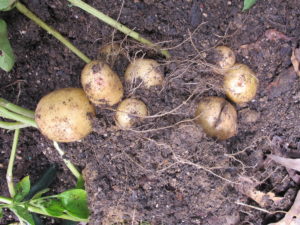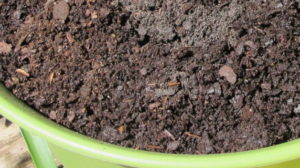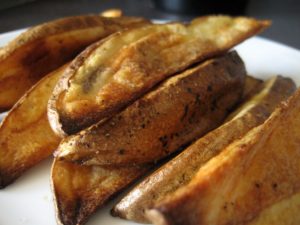Page 2
Step 5: Harvesting!
Okay, this is the day we’ve been waiting for.
Potato plants begin dying down with summer’s heat. You’ll see yellowing foliage after 3 or 4 months of growth. A week later, start digging through the soil—carefully—for those tender spuds. Keeping them in the ground for a while after the foliage deteriorates conditions the skins. Late crops can stay in the cooling ground for a longer period of time.
Wipe off excess soil and wait for surfaces to dry before storing. Keep them in total darkness (to prevent greening) at around 37-40°F.

It’s like looking for buried treasure. The more you dig, the more you’ll find! I was astonished by the yield, many years ago, after planting 2 small potatoes in a large pot filled with potting soil and compost. That was the first time I’d grown potatoes and the harvest filled a stockpot.
If you can’t wait for the mature harvest, you can feel around the soil for “new” potatoes. These small, tender, sugary tubers form after about 7-8 weeks of growth. Avoid unnecessary disruption of the surrounding roots.
My home state of North Carolina produces 200 million pounds of potatoes annually. More than 70% end up as potato chips. If you live on the east coast, those potato chips you’re eating most likely originated in North Carolina.
How To Grow Potatoes in Containers

Most garden crops can be grown in containers. Because of the limited soil volume, they’ll need more frequent attention than crops in the garden.
Following the suggestions for garden-planted potatoes, you can grow potatoes in large pots (maybe 2-3 seed potatoes per 18-20″ pot). Place them on the sunny patio or balcony. Lack of adequate sunlight reduces the yield, so provide 7-8 hours of direct sunlight.
Use high quality potting soil and compost, and incorporate damp peat moss to acidify the soil. Keep the soil evenly moist and fertilize every few weeks.
Roots of potted plants feel fluctuations in temperature before roots of garden-grown plants. They’re simply not insulated by the mass of surrounding soil, which is slow to change. Black pots on a cool, sunny day will warm up faster than light-colored pots. So, starting plants using black or very dark pots might work better when it’s still chilly outside. As temperatures increase, however, shade the pot (not the foliage) to keep the soil cooler.
Listen to the weather forecast and act appropriately. I would move a leafy potted potato to the garage or indoors to a cool location if the temperature is expected to drop below 42-45° outdoors. Although that’s not near frost, the roots will feel the colder conditions because they’re exposed to ambient air. The plant will be fine with 1 or 2 somewhat cooler nights, but consistently cold soil can delay development or rot the tubers.
Placing a potted potato next to a south-facing wall (northern hemisphere)—in a warmer microclimate—gives a few degrees of protection.
Grow Potatoes For Their Nutrients
One medium potato with the skin contains:
- approximately 160 calories
- 37 g. carbohydrates
- 3.8 g. fiber
- 4.3 g. protein
- about 1/4 of the recommended daily value of vitamins B6 and C, manganese, and potassium
- 1/8 of the needed folate, niacin, magnesium, phosphorus, and zinc
- some phosphorus, calcium, and copper
- prebiotics for a healthy gut biome
- antioxidants, especially in red, blue, and purple potatoes (skins have 12 times more antioxidants than white interiors)
(N.B.: Several websites I checked for nutrient content varied widely in proportions of nutrients.)
The Power of the Purples
Dr. Michael Greger indicates that potatoes with purple skin and flesh contain 20 times more antioxidants than white potatoes, similar to levels in berries. ‘Yukon Gold’, a distant second, contains twice the antioxidant compounds compared to white potatoes. Purple potatoes are the best at reducing inflammation and can help lower blood pressure.
The glycemic index (GI) measures how food influences blood sugar levels after eating a meal. Foods with a high GI can contribute to developing type 2 diabetes. Potatoes have a lower GI when eaten after they’ve been cooked and then cooled. Even reheated cooked potatoes have a lower glycemic index. Cooling alters the starch chemistry, lessening its impact on our insulin levels.
Another way to decrease the impact of potatoes’ GI is to eat them with a large serving of broccoli! That can cut the insulin demand by 40% compared to eating heated potatoes. Cold potato salad, with its lower glycemic index, also cuts insulin demand by 40%.
While Dr. Greger’s examination of the research shows boiled potatoes to be the most satiating food, that’s my least favorite way to prepare them—unless they’re mashed.
‘Yukon Gold’ is my favorite for mashing. After simmering potato chunks with their skins on, they’re put through the ricer. I save the skins and process them with a small amount of milk, then add that back to the bowl. It will look “gluey” when coming out of the processor but isn’t detectable when mixed with the rest of the potatoes.
Potato Skins
Potato skins contain the highest amounts of vitamins, fiber, and antioxidants—much more than the flesh. That’s true for other fruits and vegetables. If the skins are edible, you’ll get far more nutrients by eating them.
In addition to eating skins of potatoes and sweet potatoes, I don’t peel carrots, cucumbers, eggplant, zucchini, apples, or peaches. Some vegetable varieties are listed in seed catalogues as having “thin skin”. Young fruits normally have more tender skins than mature fruits.
Resistant Starch
The fiber in potatoes is primarily insoluble. Some of the fiber is a type called “resistant starch”, which feeds our beneficial gut bacteria. Resistant starch, especially in cold potatoes, is also believed to improve regulation of blood sugar levels. Once again, because skins contain the most fiber, don’t discard them!
Cooking potatoes with their skins on retains higher levels of nutrients, even with boiled potatoes.
The Problem With High Heat
Earlier, in the “Greening”? section, I mentioned a problem with cooking vegetables at high temperatures.
Unhealthy chemicals can form when starchy foods, such as potatoes, cook to a crispy, deep brown color. Long-term exposure to this toxin, called acrylamide, can cause cancer, nerve damage, and problems with the reproductive system.
Baked, roasted, and fried potatoes have more acrylamide than those boiled in water or steamed. French fries and potato chips have high levels of the chemical. Even deep brown toast, dark roast coffee beans, and roasted nuts have elevated levels of the chemical!
Acrylamide forms when sugars and an amino acid, called asparagine, react chemically at high temperatures. This is called the Maillard Reaction. Delicious? Yes. Deadly? Maybe not for you or not now, but I wouldn’t make a habit of it.
Refrigerated raw potatoes contain more potential for acrylamide formation than those stored in a cool, dark cellar or pantry. Potatoes stored cold have converted more starch to sugar; when fried or roasted, these potatoes look darker. (***Update***: Although the last bag of potatoes was kept in as cool a location as I have outside the refrigerator, the potatoes quickly deteriorated. I eat them infrequently, so, in the future, I’ll store them in the fridge to prevent spoilage. The next appliance will have a cool vegetable drawer. July 2023)
A buttery batch of mashed potatoes (with skins processed and added back) is one of my favorite comfort foods. We also enjoy hash browns made with greens, mushrooms, onion, and egg, and an occasional baked potato with broccoli and cheddar cheese. Not often, though.
I don’t cook anything at high heat, and now we know there’s good reason not to.

Roasted potatoes with skins.
Headings
Page 1: Can we grow new potatoes from old potatoes? (When can we grow potatoes outside?, Seed Potatoes, Crop Rotation), How To Grow Potatoes In the Garden, Step 1: The First Cut, Step 2: Prepare the Soil If You Want To Grow Potatoes (Soil PH), Step 3: Place the Seed Potatoes (“Greening”?), Step 4: Maintenance (Water, Hollow Heart and Brown Center, Hilling Up, Fertilizer, Insect Pests, Slugs and Deer)
Page 2: Step 5: Harvesting!, How To Grow Potatoes In Containers, Grow Potatoes For Their Nutrients (The Power of the Purples, Potato Skins, Resistant Starch), The Problem With High Heat